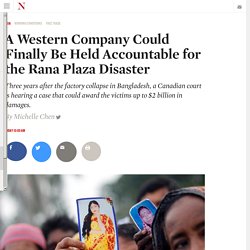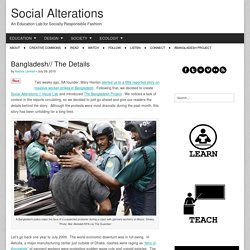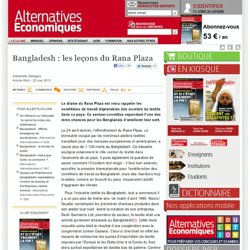

Hine, Lewis Wickes. A Western Company Could Finally Be Held Accountable for the Rana Plaza Disaster. Three years after the Rana Plaza factory collapsed on the outskirts of Dhaka, the lives that were shattered have still not been allowed to heal.

Since the day more than 1,100 people were buried in the wreckage of the shoddily constructed manufacturing complex, we are just starting to discover among the ruins what global worker justice should look like. For victims, there has been halting progress, according to International Labor Rights Forum (ILRF). A $30 million donor trust fund has issued several thousand payments to survivors and households of the deceased, ranging from about $1,340 for an injured survivor to 10 times that amount for families of the deceased. Other aid funds, such as one established by the multinational Primark, have been established independently to provide long-term medical aid. But a few survivors are resisting business as usual.
At the time of the collapse, even ordinary workers understood the hazards. The future is even shakier for Bangladesh’s labor movement. Rana Plaza et tous les autres. Effondrement du Rana Plaza / Bangladesh. Bangladesh police open fire at collapsed garment factory protest. Protesters at the former Rana Plaza site held up pictures of victims of the disaster. Photograph: Reazsumon/Demotix/Corbis Police in Bangladesh have opened fired at a protest by former workers of a factory making clothes for western retailers that collapsed, who had taken to the streets to complain at their treatment by the authorities since the disaster six weeks ago. The protests took place close to the site of the former Rana Plaza factory, now entirely demolished, in Savar, Many garment factories are concentrated in the town near the capital Dhaka.
The death toll from the Rana Plaza disaster now stands at 1,130. Hundreds of protesters, including former workers as well as relatives of victims killed or injured, were demonstrating to demand compensation or outstanding salaries promised by the government and the main body representing local employers in the booming industry, the Bangladesh Garments Manufacturers and Exporters Association (BGMEA). Protesters denied causing any damage. Taslima Akhter's Photographic Camapign Against Sweatshops. Taslima Akhter was overcome with emotion when she arrived at the Tazreen Fashions garment factory on the outskirts of Dhaka, Bangladesh, on Sunday evening, four hours after fire tore through the building.

She watched firefighters battle the blaze — which killed at least 112 people — as throngs of workers and family members waited to see if their loved ones had survived. She was overwhelmed, but not surprised. Ms. La vraie tragédie du Bangladesh. Un matin d'avril 1980, Noorul Quader contemplait son atelier textile tout récemment construit, produire ses premières chemises.

Son entreprise, Desh Garments ltd, était une pionnière dans ce secteur. Avant sa création, le textile au Bangladesh comptait en tout et pour tout 40 ouvriers, autant dire rien. Cette toute nouvelle usine était le résultat d'une coopération avec le conglomérat coréen Daewoo, qui cherchait des moyens de contourner les quotas d'importation de textiles imposés à la Corée du Sud par l'Europe et les Etats-Unis. Comme le Bangladesh n'avait aucune production textile, dans leur grande générosité, européens et américains n'avaient soumis ce pays à aucun quota. Daewoo s'était associé à Noorul Quader, un ancien fonctionnaire qui disposait des connections indispensables pour créer une entreprise dans un pays aussi corrompu que le Bangladesh.
Les débuts de Desh ont été modestes. Que s'est-il passé? Bangladesh// The Details. Two weeks ago, SA founder, Mary Hanlon alerted us to a little reported story on massive worker strikes in Bangladesh.

Following that, we decided to create Social Alterations // Visual Lab and introduced The Bangladesh Project. We noticed a lack of context in the reports circulating, so we decided to just go ahead and give our readers the details behind the story. Although the protests were most dramatic during the past month, this story has been unfolding for a long time. Let’s go back one year to July 2009. The world economic downturn was in full swing. “Since early 2008, salaries have been cut by an average of up to 30 percent, according to union leader Tauhidul Islam who said this week’s violence had been fuelled by desperation. The government’s Factory Inspection Department said this week that 122 of 825 factories surveyed – or 14.7 percent – between January and May did not pay staff on time with eight not even paying the minimum wage.”
“We reject the proposed wage structure. Bangladesh : les leçons du Rana Plaza. Le drame du Rana Plaza est venu rappeler les conditions de travail déplorables des ouvriers du textile dans ce pays.

Ce secteur constitue cependant l’une des rares chances pour les Bangladais d’améliorer leur sort. The Life and Struggle of Garment Workers. 6 Flares Twitter 6 Facebook 0 6 Flares × Subscribe to ShahidulNews Photography Exhibition, Dhaka Drik Gallery, Dhanmondi 26 October – 1 November 2010 3-8 pm, everyday Launching ceremony at 4pm on 25 October 2010 in Grand Ball Room of Sonargaon Hotel.
